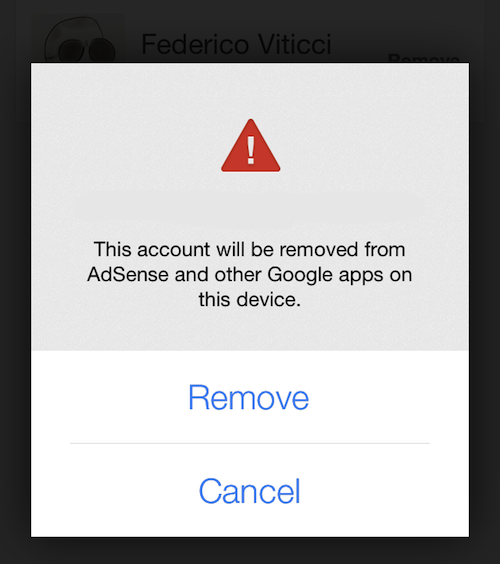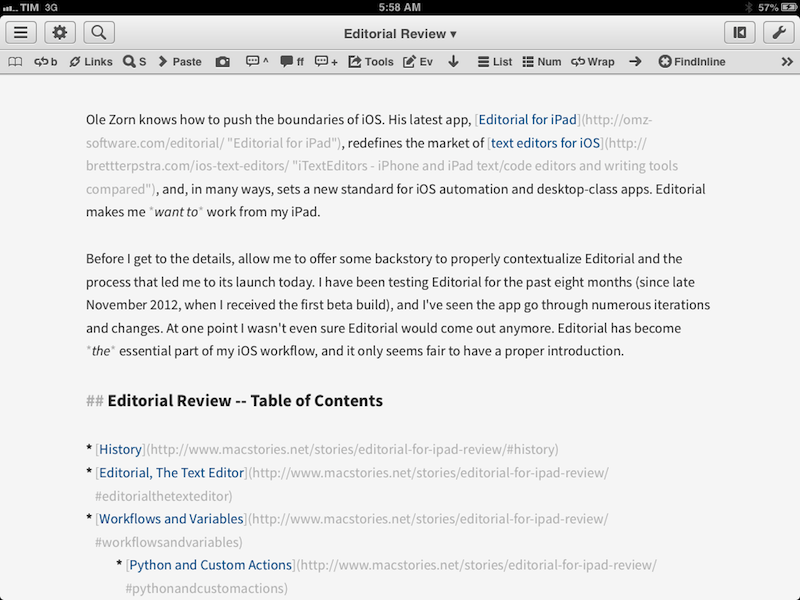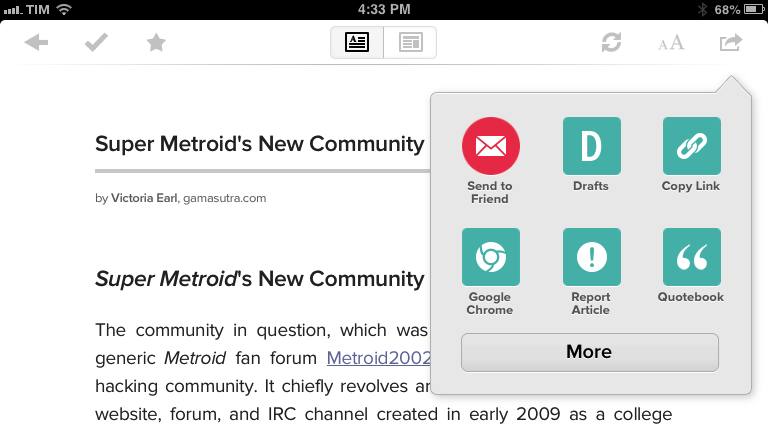If you’re still new to iOS 7 and want to check out or tips, previews, and news, check here. Here are some great #MacStoriesDeals today! You can find us as @MacStoriesDeals on Twitter.
Posts tagged with "iOS"
#MacStoriesDeals - Monday
#MacStoriesDeals - Friday
On the heals of iOS 7 and new iPhones, here are some great #MacStoriesDeals! You can find us as @MacStoriesDeals on Twitter.
Mirimage’s Editorial Workflows for Pocket and App.net→
Great demonstration of Editorial’s scripting capabilities. First, a workflow to fetch a random article from Pocket:
I’ve made 3 workflows; two for the authentication (Pocket Auth 1 & 2), and one that fetches a random article from the user’s unread queue and opens it in the Editorial browser. The Pocket authentication only needs to run once.
And then one to post on App.net (which could be nicely chained to my Post To WordPress workflow):
If you’re an App.net Developer, you can post to App.net directly from Editorial. I integrated this workflow into Federico Viticci’s Post to WordPress workflow, to post new articles to App.net in addition to Twitter.
Side note: I’m keeping track of Editorial workflows I find over at this Pinboard tag.
Shared Accounts In Google’s iOS Apps
Alex Chitu, reporting on a feature that I also noticed after YouTube’s 2.0 update:
If you enter the credentials of a Google account in the YouTube app and then open the AdSense app, you’ll find the new account and you can sign in without entering the password. If you remove an account, it will be removed from the other Google apps that support this feature. I assume that most Google apps for iOS will be updated to use this brilliant feature.
Once I logged into YouTube with my account (on an iOS 7 device), I then fired up the AdSense app (that I had just downloaded from the App Store) and my account was already listed in the screen with available accounts. It does seem like the YouTube and AdSense apps are capable of sharing accounts so users won’t have to log into their account every time in each Google app. AdSense didn’t bring up an authorization screen in YouTube – it just recognized the account that I had set up in YouTube.
Google’s documentation for YouTube confirms this, but doesn’t specify which iOS apps support shared accounts:
If you’ve signed in with another Google app on your iOS device, you may see this account listed.
Google’s explanation isn’t clear; the shared account option isn’t mentioned in the documentation for Gmail and Chrome. Upon signing out from the YouTube app, an alert dialog reads:
To sign in again, just select one of your Google accounts saved on this device. You will not be required to enter your password. To remove a saved account, tap “Sign In” > “Manage” > “Remove”.
It’ll be interesting to see if and when shared accounts will be integrated with Google’s other iOS apps. In the past few months, Google enhanced the inter-app communication capabilities of Gmail, Maps, Drive, and Chrome with the ability to open links in other apps, completely foregoing the need to launch Apple apps like Safari, Maps, or Mail.
Furthermore, Google is also providing an SDK for developers to add this functionality to their apps (for web links), showcasing examples of third-party apps that support Chrome. While Google apps won’t have the same kind of system integration that they have on Android, the combination of URL callbacks and shared accounts could help the creation of a “Google app ecosystem” on iOS.
Reinventing iOS Automation: Editorial Review
Update: I have turned this review into an interactive book with additional & exclusive content. You can find it on iTunes, on sale for a limited time. More information is available here.
Ole Zorn knows how to push the boundaries of iOS. His latest app, Editorial for iPad, redefines the market of text editors for iOS, and, in many ways, sets a new standard for iOS automation and desktop-class apps. Editorial makes me want to work from my iPad.
Before I get to the details, allow me to offer some backstory to properly contextualize Editorial and the process that led me to its launch today. I have been testing Editorial for the past eight months (since late November 2012, when I received the first beta build), and I’ve seen the app go through numerous iterations and changes. At one point I wasn’t even sure Editorial would come out anymore. Editorial has become the essential part of my iOS workflow, and it only seems fair to have a proper introduction.
The Boy Who Beat Ocarina of Time in 22 Minutes→
This link isn’t strictly about Cosmo Wright’s Ocarina of Time speedrun – which, by the way, is incredible to watch. Make sure to read Computer and Video Games’ feature on it as well.
Rather, I’d like to point out these two tweets by Sonny Fazio in response to Peter Hajas, who originally shared the link to Cosmo Wright’s speedrun last night:
@peterhajas Great read. Makes you wonder if this will still be possible with how easy it is now for devs to ship bug fixes.
— Sonny Fazio (@sonnyfazio) August 8, 2013
@peterhajas it seems like most of those tricks were more or less bugs that never got patched. Once the game shipped, that was it for fixes.
— Sonny Fazio (@sonnyfazio) August 8, 2013
This is an interesting side effect of the App Store that I didn’t think about. Speedruns are an extremely fun-to-watch, but niche use case that, as Fazio notes, are generally facilitated by glitches and bugs in the source code of games. This goes beyond the App Store and extends to games sold on online platforms like Steam and PlayStation Network as well. Because of updates and patches, will it become increasingly difficult – if not impossible – for speedrunners to analyze and play through games in their original form decades from now?
In the video I linked above, for instance, Cosmo explains that a major glitch in Ocarina of Time took 13 years to be discovered and used. That was only possible thanks to the fact that a) Nintendo 64 cartridges are still physically available today and b) Nintendo’s conversion for the Wii’s Virtual Console is a 1:1 port of the original – bugs and glitches included. Can you imagine someone still playing an iOS game in 13 years?
Twenty or thirty years from now, will we see speedruns for iOS, PS3, or Xbox 360 games? Sadly, I think that a mix of retrocompatibility issues, OS and app updates, and lack of physical access to games will hinder speedrunning. Not to mention Apple’s current state of affairs with games and the gaming community.
Overall, Digital preservation is the bigger topic we should be discussing.
Byword For iOS Gets Improved URL Scheme→
In a minor update released today, Byword developers Metaclassy have brought an improved URL scheme (based on x-callback-url) to the app, enabling actions for creating, opening documents, and manipulating text. Documentation is available here.
The actions supported by the URL scheme are:
newopenappendprependreplace
With these actions, you can now send text to a specific file in Byword, choosing to either create/open an existing document, insert text at the top (prepend) or bottom (append), or replace the entire contents of a document with new text. When using the Byword URL scheme, you’ll need to percent-encode text, which can be easily done using Launch Center Pro’s encode actions or Drafts’ double curly brackets.
This improved URL scheme creates some new interesting possibilities for iOS automation with Byword. I imagine many will experiment with workflows to append or create text from Mr. Reader’s Services menu, take notes with Drafts, or prepend text from Safari or Chrome using a browser bookmarklet. However, I still think that the URL scheme could be expanded to include support for triggering Publishing actions automatically, optionally supporting x-success to go back to another app after a post has been sent to a service integrated in Byword. With Poster no longer receiving updates, I believe the folks at Metaclassy have a great opportunity to keep Byword the simple and elegant iOS text editor that many love, while also adding advanced functionality that power users will come to rely upon in their daily workflows.
Check Dev Center Status From iOS with Pythonista→
A great idea by reader Nicolas Hoibian, which uses BeautifulSoup to fetch the source code of Apple’s System Status page, parse it, and print it with custom fonts and colors in Pythonista’s console.
Here’s my modified version that uses Pythonista’s notification module to re-run the script every 6 hours by firing a local iOS notification on your iPhone or iPad (it assumes the script is named “DevCenter” in Pythonista).
Resolve Short URLs with Pythonista on iOS
I don’t like it when third-party apps or services force me to share links to articles or webpages using their own custom shortened links. I understand the appeal of personalized short domains – after all, we tweet mcstr.net links with the @macstoriesnet account – as they can provide analytics to track clicks, can save characters, and, at least in theory, they “look cool”. However, I’ve been long considering the idea of dropping our mcstr.net links, but I think the issue is worse (and more annoying) for apps and services that don’t tweet links to their own content (like we do) but that override others’ links with different domains. An example is Pocket, which gives you the clean, original URL when you choose the “Copy Link” action from the sharing menu, but that instead returns pocket.co links when sending text to Drafts (which I do often). I’ve grown tired of this practice (in Pocket and other services), and I’ve put together a workflow based on a Python script that allows me to easily resolve short links without having to open the browser and tap on multiple menus. Read more





